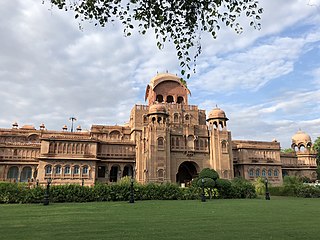
Bikaner is a city in the northwest of the state of Rajasthan, India. It is located 330 kilometres (205 mi) northwest of the state capital, Jaipur. Bikaner city is the administrative headquarters of Bikaner District and Bikaner division. The Collector and District Magistrate of Bikaner is Sh. Bhagwati Prasad Kalal, and the Superintendent of Police is Tejaswini Gautam IPS.

Aihole, also referred to as Aivalli, Ahivolal or Aryapura, is a historic site of ancient and medieval era Buddhist, Hindu and Jain monuments in Karnataka, India that dates from the sixth century through the twelfth century CE. Most of the surviving monuments at the site date from the 7th to 10th centuries. Located around an eponymous small village surrounded by farmlands and sandstone hills, Aihole is a major archaeological site featuring over one hundred and twenty stone and cave temples spread along the Malaprabha river valley, in Bagalakote district. Hunagunda Taluk Distance 35 km

The Chitharal Jain Monuments and Bhagavati Temple, also known as Chitharal Malai Kovil, Chitaral Cave Temple or Bhagavati Temple, are located near Chitharal village in Kanyakumari district, Tamil Nadu, India. They consist of stone beds with inscriptions, and two monuments – one rock cut Jain temple with outer wall reliefs and one Hindu goddess temple next to it that is a combination of rock-cut and stone that was added during the reign of Vikramaditya Varaguna Pandya. The monuments are from the 9th century CE.

Sittanavasal Cave is a 2nd-century Tamil Śramaṇa complex of caves in Sittanavasal village in Pudukottai district of Tamil Nadu, India. Its name is a distorted form of Sit-tan-na-va-yil, a Tamil word which means "the abode of great saints".

Panchakuta Basadi is a temple complex located in the Kambadahalli village of the Mandya district, Karnataka state, in southwestern India. It is one of the finest examples of South Indian Dravidian architecture of the Western Ganga variety, related to the Jain faith and iconography.
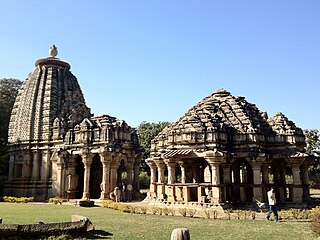
The Baroli Temples Complex, also known as the Badoli temples, is located in Baroli village in Rawatbhata City in Chittorgarh district of Rajasthan, India. The complex of eight temples is situated within a walled enclosure; an additional temple is about 1 kilometre (0.62 mi) away. They are built in the Gurjara Pratihara style of temple architecture dated to the tenth century CE and was destroyed by Mughal emperor Aurangzeb during his Rajasthan quest. All nine temples are under the control of the Archaeological Survey of India for conservation and protection. A well known art critic characterised "the creations of Badoli as the most perfect of their age that he had encountered within that part of the country and, in their own peculiar style."
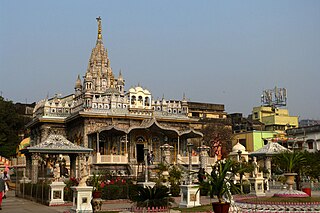
Calcutta Jain Temple is a Jain temple at Badridas Temple Street, Gouribari in Maniktala and a major tourist attraction of Kolkata (Calcutta), India. The temple was built by a Jain named Rai Badridas Bahadoor Mookim in 1867. Pratishtha was done by Sri Kalyansurishwarji Maharaj.

Ranakpur Jain temple or Chaturmukha Dharana Vihara is a Śvētāmbara Jain temple at Ranakpur dedicated to Tirthankara Rishabhanatha. The temple is located in a village of Ranakpur near Sadri town in the Pali district of Rajasthan.
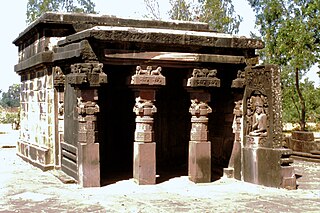
Tigawa is a village in Indian state of Madhya Pradesh and an archaeological site with a complex of about 36 Hindu temple ruins. Of these, the small but important and ancient Kankali Devi Temple is in good condition, and is usually dated to about 400-425 CE. Unless another building is mentioned, references to "the temple" below refer to this.

The Kaitabheshvara temple is located in the town of Kubatur, near Anavatti in the Shimoga district of Karnataka state, India. The temple was constructed during the reign of Hoysala King Vinayaditya around 1100 AD. The Hoysala ruling family was during this time a powerful feudatory of the imperial Western Chalukya Empire ruled by King Vikramaditya VI. According to the Archaeological Survey of India, the architectural signature of the temple is mainly "Chalukyan". Art historian Adam Hardy classifies the style involved in the construction of the temple as "Later Chalukya, non mainstream, far end of spectrum". The building material used is soapstone The temple is protected as a monument of national importance by the Archaeological Survey of India.

The Nageshvara-Chennakeshava temple complex, sometimes referred to as the Nagesvara and Chennakesava temples of Mosale, are a pair of nearly identical Hindu temples in the village of Mosale near Hassan city, Karnataka, India. One for Shiva, other for Vishnu, this pair is a set of highly ornamented stone temples, illustrating the Hoysala architecture. These temples also include panels of artwork related to the goddess tradition of Hinduism (Shaktism) and Vedic deities. Another notable feature of these temples is the artwork in their ceilings, how the shilpins (artisans) integrated the historic pre-Hoysala architectural innovations from the Chalukya era. Further, the temples include north Indian Bhumija and south Indian Vesara aedicules on the outer walls above the panels. It is unclear when this temple pair was built, but given the style and architectural innovations embedded therein, it was likely complete before 1250 CE.

Akkana Basadi is a Jain temple (basadi) built in 1181 A.D., during the rule of Hoysala empire King Veera Ballala II. The basadi was constructed by the devout Jain lady Achiyakka, wife of Chandramouli, a Brahmin minister in the court of the Hoysala king. The main deity of the temple is the twenty-third Jain Tirthankar Parshwanath. The temple is protected as a monument of national importance by the Archaeological Survey of India. It is part of an Archaeological Survey of India Adarsh Smarak Monument along with other temples in the Shravanabelagola group of monuments.
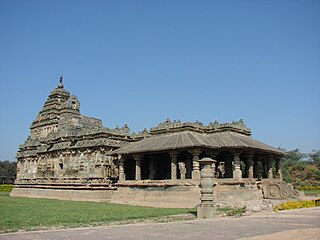
The Brahma Jinalaya, sometimes called as the Greater Jain Temple of Lakkundi, is an early 11th-century Mahavira temple in Lakkundi, Gadag District of Karnataka state, India. The temple is attributed to Attiyabbe, the wife of the local governor Dandanayaka Nagadeva. It faces east, has a mukhamandapa, a gudhamandapa and its sanctum is covered by a sur-temple style vimana superstructure. The temple is notable for its reliefs depicting Jaina artwork, statues of the Tirthankaras and the two Hindu statues of Brahma and Saraswati inside its inner mandapa.

Jain Basadi complex in Halebidu, Hassan district consists of three Jain Basadis dedicated to the Jain Tirthankars Parshvanatha, Shantinatha and Adinatha. The complex is situated near Kedareshwara temple and Dwarasamudra lake. These temples were constructed in the 12th century during the reign of Hoysala Empire along with Kedareshwara temple and Hoysaleswara Temple have been proposed to be listed under UNESCO World Heritage Site. The temple complex also includes a step well called Hulikere Kalyani.
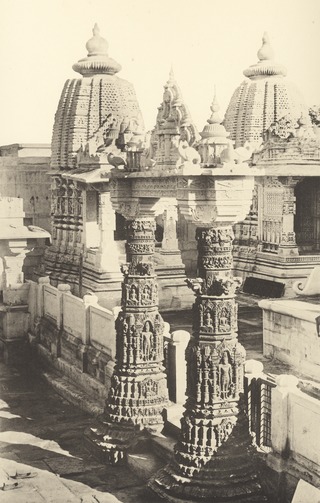
The Mahavira Jain temple is built in Osian of Jodhpur District, Rajasthan. The temple is an important pilgrimage of the Oswal Jain community. This temple is the oldest surviving Jain temple in Western India and was built during the reign of Mahārāja Śrī Vatsarāja of Imperial Pratihāras. The temple is visited by both Jain and Hindu.

The Naugaza Digambar Jain temple is situated near Naugaza in Alwar District, Rajasthan. The temple is situated near Neelkanth temple, Alwar.

The Samadhishvara Temple is a Hindu temple located in the Chittor Fort in Rajasthan, India. It is dedicated to Shiva, who is called "Samadhishvara", that is, "Lord of Samadhi". Epigraphic evidence suggests that the temple was constructed in the 11th century, and was further restored in the 13th and the 15th centuries.
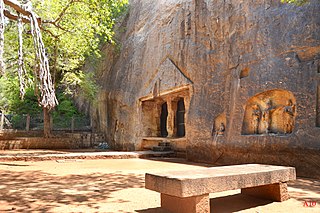
Thirupparankundram Rock-cut Cave and Inscription, also known as Umai Andar or Umaiyandar temple, is a rock cut cave temple with inscriptions at the foot of the Thirupparankundram rock hill's south face. It is located in the town of Thirupparankundram, about 10 kilometres (6.2 mi) southwest of Madurai city, Tamil Nadu, India. It consists of several layers of construction, the earliest is dated to the 8th-century early Pandya period, and the last to the 13th century.

Jaisalmer Fort Jain temples is a group of 7 Jain temples inside Jaisalmer Fort in state of Rajasthan. The Jaisalmer Fort is UNESCO World Heritage Site as part of Hill Forts of Rajasthan and is famous for its ancient Jain temples. The temples are well known for their intricate carvings and attract many tourists and religious devotees.

Chamatkarji is an important Jain temple located near Ranthambore Fort in the city of Sawai Madhopur in Rajasthan.






























